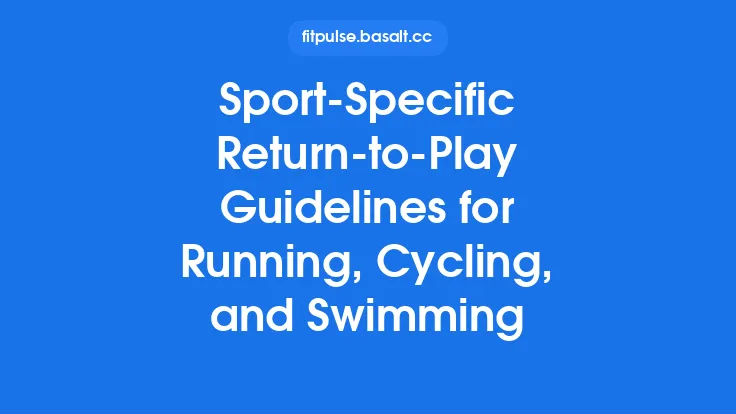Sport‑specific training customization is the art and science of shaping a training program so that every minute spent on the field, court, or pool directly advances the performance goals of a particular sport. While the underlying principles of program design—progressive overload, specificity, and recovery—remain constant, the way they are applied can differ dramatically between a high‑intensity, intermittent sport like soccer and a technically demanding, predominantly aerobic sport like swimming. This article explores how to translate the universal tenets of training into bespoke plans that respect the unique physiological, biomechanical, and tactical demands of each discipline, providing a roadmap that coaches, athletes, and performance specialists can adapt across a wide spectrum of sports.
Understanding the Unique Demands of Each Sport
Every sport can be broken down into a combination of three primary performance domains:
- Physical Demands – energy‑system reliance, force production, speed, endurance, and fatigue resistance.
- Technical Demands – sport‑specific movement patterns, skill execution, and coordination.
- Tactical Demands – decision‑making, situational awareness, and game‑plan implementation.
A thorough analysis begins with a sport‑specific demand profile (SSDP), a matrix that quantifies the relative contribution of each domain. For soccer, the SSDP typically shows a high proportion of intermittent high‑intensity running (≈30 % of total distance above 20 km·h⁻¹), frequent changes of direction, and a substantial technical component (ball control, passing). In contrast, swimming’s SSDP emphasizes sustained aerobic output (≈70 % of race time at 70–80 % VO₂max), precise stroke mechanics, and a lower proportion of explosive power (except in sprint events).
Creating a visual SSDP (e.g., radar chart) helps stakeholders quickly see where training emphasis should be placed and where trade‑offs may be necessary. The SSDP also informs the selection of assessment tools, periodization models, and the balance between on‑water/on‑field work and off‑sport conditioning.
Energy System Profiling and Its Role in Program Design
Energy system contribution is the cornerstone of sport‑specific conditioning. The three primary systems—phosphagen (ATP‑PCr), glycolytic (anaerobic), and oxidative (aerobic)—operate on different time scales and fuel distinct performance tasks.
| Sport | Dominant Energy System(s) | Typical Duration of High‑Intensity Bouts | Recovery Interval |
|---|---|---|---|
| Soccer (field play) | Phosphagen & Glycolytic (≈30 % each) | 2–6 s sprints, 10–30 s high‑intensity actions | 15–30 s active recovery |
| Swimming (mid‑distance) | Oxidative (≈70 %) + Glycolytic (≈20 %) | 30–120 s sustained high‑intensity effort | 30–60 s active recovery |
| Swimming (sprint) | Phosphagen (≈60 %) + Glycolytic | ≤30 s maximal effort | 2–4 min passive recovery |
Understanding these profiles guides the distribution of conditioning modalities:
- High‑Intensity Interval Training (HIIT) for soccer: short, maximal sprints with brief active recoveries replicate match play demands.
- Threshold Sets for swimming: longer intervals at 85–90 % of maximal aerobic speed develop the oxidative capacity needed for sustained speed.
- Sprint‑Specific Power Work for swimming sprints: 15–30 s maximal efforts with full recovery to target phosphagen replenishment.
The key is to match the duration, intensity, and recovery of conditioning drills to the sport’s natural work‑rest ratios, ensuring that physiological adaptations are directly transferable to competition.
Movement Pattern Analysis: From Footwork to Stroke Mechanics
Biomechanical specificity is equally critical. While soccer relies heavily on multi‑planar lower‑body actions—accelerations, decelerations, lateral shuffles, and jumps—swimming demands coordinated, cyclical upper‑body and lower‑body movements within a fluid environment.
Soccer Movement Patterns
- Change‑of‑Direction (COD) Mechanics: Emphasize deceleration force, plant foot angle, and re‑acceleration impulse.
- Jump‑Landing Dynamics: Focus on knee valgus control and eccentric strength to improve aerial duels.
- Lateral Shuffle Efficiency: Optimize hip abductor activation to reduce energy cost during defensive maneuvers.
Swimming Movement Patterns
- Stroke Cycle Phases: Catch, pull, push, recovery (for freestyle); similar phase breakdowns exist for butterfly, backstroke, and breaststroke.
- Body Roll and Streamline: Efficient rotation reduces drag and improves propulsion.
- Kick Timing: Synchronization with arm pull maximizes thrust while minimizing wasted motion.
A movement audit—using video analysis, force plates (soccer), or underwater motion capture (swimming)—identifies technique deficits that can be corrected through targeted drills. For soccer, small‑sided games with constraints (e.g., limited touches) can reinforce efficient COD patterns. In swimming, drill sets such as “single‑arm catch” or “vertical kicking” isolate specific phases for refinement.
Periodization Strategies Tailored to Competitive Calendars
Periodization structures training into macro‑, meso‑, and micro‑cycles, aligning physiological peaks with key competitions. The optimal model varies with the sport’s seasonality and competition frequency.
Soccer: Block Periodization with In‑Season Micro‑Cycles
- Pre‑Season (8–12 weeks): Emphasize aerobic base, strength, and technical integration.
- In‑Season (12–20 weeks): Adopt a micro‑cycle of 5–6 days, balancing match play, recovery, and targeted conditioning.
- Tapering: Reduce training volume 48–72 h before high‑stakes matches while maintaining intensity to preserve neuromuscular readiness.
Swimming: Traditional Linear Periodization with Double‑Peak Planning
- General Preparation Phase (GPP): 4–6 weeks of high‑volume, low‑intensity swimming to develop aerobic foundation.
- Specific Preparation Phase (SPP): 6–8 weeks of race‑pace intervals, stroke‑specific drills, and anaerobic threshold work.
- Competition Phase: Two peaks—one for national trials, another for major championships—are achieved by tapering volume (30–50 % reduction) while maintaining or slightly increasing intensity.
Both sports benefit from deload weeks (reduced load, increased recovery) every 4–6 weeks to mitigate cumulative fatigue. The timing of deloads should be synchronized with low‑stress periods in the competition calendar (e.g., international breaks in soccer, off‑season in swimming).
Assessment and Monitoring Tools for Sport‑Specific Progress
Objective data drives program adjustments. The choice of metrics must reflect the sport’s performance determinants.
Soccer Monitoring Suite
| Metric | Tool | Relevance |
|---|---|---|
| Sprint speed (0‑10 m, 0‑30 m) | Timing gates, GPS | Directly linked to breakaway ability |
| High‑Intensity Running Distance | GPS/accelerometer | Correlates with match‑play workload |
| COD efficiency | Force plates, video analysis | Predicts defensive agility |
| Technical proficiency (passing accuracy) | Video coding, performance analytics | Influences possession retention |
Swimming Monitoring Suite
| Metric | Tool | Relevance |
|---|---|---|
| Stroke rate & distance per stroke (DPS) | Wearable swim watches, video | Determines propulsion efficiency |
| Lactate threshold pace | Blood lactate analyzer | Guides aerobic training intensity |
| Start and turn times | High‑speed cameras | Critical for sprint events |
| VO₂max (pool or treadmill) | Metabolic cart, tethered swim test | Baseline aerobic capacity |
Regular testing (every 4–6 weeks) creates a performance trajectory that highlights plateaus or regressions, prompting targeted interventions. Additionally, subjective wellness questionnaires (sleep quality, perceived fatigue) complement objective data, ensuring a holistic view of athlete readiness.
Designing Training Sessions: Balancing Skill, Conditioning, and Tactical Elements
A sport‑specific session should weave together three strands:
- Technical/Skill Component – the “what” of the sport (e.g., ball control, stroke mechanics).
- Conditioning Component – the “how fast/long” the athlete can execute the skill under fatigue.
- Tactical/Decision‑Making Component – the “when” and “where” the skill is applied in game context.
Soccer Session Blueprint (90 min)
| Phase | Duration | Focus | Example |
|---|---|---|---|
| Warm‑up | 10 min | Dynamic mobility, activation | A‑skip, high‑knee runs, glute bridges |
| Technical | 20 min | Ball‑handling under low fatigue | Rondo with limited touches |
| Conditioning | 20 min | HIIT replicating match bursts | 6 × 30 s shuttle sprints (20 m) with 30 s jog |
| Tactical | 30 min | Small‑sided game with positional constraints | 5‑vs‑5 with “press after loss” rule |
| Cool‑down | 10 min | Light jog, static stretching | 5 min jog + 5 min stretch |
Swimming Session Blueprint (75 min)
| Phase | Duration | Focus | Example |
|---|---|---|---|
| Warm‑up | 10 min | Aerobic activation, technique | 400 m easy freestyle + 4 × 50 m drill |
| Skill | 15 min | Stroke refinement under moderate load | 8 × 25 m “catch‑up” drill with 15 s rest |
| Conditioning | 30 min | Race‑pace intervals | 5 × 200 m at 85 % race pace, 30 s rest |
| Tactical | 10 min | Starts & turns under fatigue | 6 × 25 m sprint from block, 2 min rest |
| Cool‑down | 10 min | Recovery swim, breathing work | 200 m easy backstroke + 5 min relaxed breathing |
The integration of these components ensures that athletes practice skills while simultaneously training the physiological systems required to execute them under competition stress.
Integrating Technology and Data Analytics
Modern sport‑specific programming leverages technology to capture granular data and translate it into actionable insights.
- Wearable Sensors: GPS units for soccer (10 Hz) provide real‑time speed, acceleration, and load metrics; inertial measurement units (IMUs) for swimmers track stroke count, roll, and kick amplitude.
- Video Analytics Platforms: Automated tagging (e.g., Dartfish, Hudl) speeds up technical analysis, allowing coaches to quantify success rates of specific actions (e.g., successful passes, clean turns).
- Machine Learning Models: Predictive algorithms can forecast injury risk or performance dips based on historical load patterns, enabling proactive adjustments without compromising the article’s focus on injury prevention as a primary theme.
- Cloud‑Based Dashboards: Centralize data from multiple sources (physiological, biomechanical, subjective) to provide a single view of athlete status, facilitating communication among coaches, sport scientists, and athletes.
When implementing technology, it is essential to align data collection with the SSDP. For instance, a soccer team may prioritize high‑intensity distance and COD metrics, while a swimming squad focuses on stroke efficiency and lactate threshold pace. Over‑collecting irrelevant data can dilute focus and increase administrative burden.
Case Study: Customizing a Soccer Training Program
Athlete Profile
- Age: 22 years, professional midfielder
- Primary Goal: Increase high‑intensity running capacity and improve decision‑making speed in the final third.
SSD Profile
- 30 % high‑intensity distance (> 20 km·h⁻¹)
- 15 % COD actions per match
- Technical proficiency: 78 % pass accuracy under pressure.
Program Highlights
- Pre‑Season Conditioning Block (6 weeks)
- Aerobic Base: 3 × 30‑min continuous runs at 65 % HRmax.
- COD Circuit: 4 × 5‑minute stations (lateral shuffles, 5‑10‑5 drill, single‑leg hops) with 2 min rest.
- Technical Under Fatigue: 2 × 20‑min rondos after each conditioning session, limiting touches to 2 per possession.
- In‑Season Micro‑Cycle (7 days)
- Day 1 (Recovery): Light aerobic jog + mobility (excluded from scope).
- Day 2 (Tactical + Conditioning): 5‑vs‑5 possession game with “press after loss” rule; 6 × 30 s sprint intervals (15 m) with 30 s jog.
- Day 3 (Technical Focus): 30 min passing patterns at varying speeds, followed by 4 × 4‑minute small‑sided games emphasizing quick transitions.
- Day 4 (Rest)
- Day 5 (Match Day): Standard match preparation.
- Day 6 (Active Recovery): Low‑intensity bike + video review.
- Day 7 (Deload): Reduced volume conditioning, emphasis on tactical walkthrough.
- Monitoring
- GPS‑derived high‑intensity distance recorded each session.
- Post‑session RPE (Rate of Perceived Exertion) to gauge internal load.
- Weekly video analysis of decision‑making speed (time from ball receipt to pass).
Outcome
After 8 weeks, the midfielder’s high‑intensity distance increased by 12 % and pass accuracy under pressure rose to 84 %, while decision‑making latency decreased by 0.3 s per possession.
Case Study: Customizing a Swimming Training Program
Athlete Profile
- Age: 19 years, collegiate 200 m freestyle specialist
- Primary Goal: Lower race time by 1.5 seconds through improved aerobic efficiency and turn speed.
SSD Profile
- 70 % aerobic contribution, 20 % anaerobic threshold, 10 % phosphagen for start/turn.
- Stroke rate: 55 strokes min⁻¹, DPS: 1.85 m stroke⁻¹.
Program Highlights
- General Preparation Phase (5 weeks)
- Volume: 6 × 4000 m weekly, split into 2 × 2000 m aerobic sets at 70 % HRmax.
- Technique: 3 × 30 min drill sessions focusing on catch and body roll.
- Core Power (excluded from scope): Not emphasized.
- Specific Preparation Phase (7 weeks)
- Threshold Sets: 5 × 200 m at 85 % race pace, 20 s rest, targeting lactate clearance.
- Turn Work: 8 × 25 m from wall, focusing on underwater dolphin kick (max 15 m) and breakout timing.
- Race‑Pace Simulation: 3 × 400 m at goal race pace with 60 s rest.
- Taper (2 weeks)
- Reduce volume by 40 % while maintaining intensity (90 % race pace).
- Increase focus on start and turn repetitions: 12 × 15 m sprints from block with full recovery.
- Monitoring
- Stroke Metrics: Wearable swim watch records stroke rate and DPS each session.
- Lactate Testing: Bi‑weekly 200 m incremental test to pinpoint threshold pace.
- Video Analysis: High‑speed cameras capture turn breakout distance; coach provides immediate feedback.
Outcome
The swimmer’s DPS improved to 1.92 m stroke⁻¹, turn breakout distance increased to 12 m, and the 200 m time dropped by 1.6 seconds at the conference championships.
Practical Tips for Coaches and Athletes
- Start with a Clear SSDP – Map out the sport’s demand profile before selecting drills or conditioning methods.
- Match Work‑Rest Ratios – Design conditioning intervals that mirror the natural cadence of the sport (e.g., 1:1 for soccer sprints, 1:3 for swimming threshold sets).
- Integrate Skill Under Fatigue – The most transferable training occurs when technical execution is practiced while the athlete is physiologically taxed.
- Use Periodic Deloads – Schedule low‑load weeks strategically to prevent performance plateaus.
- Leverage Data, Not Just Intuition – Combine objective metrics (GPS, stroke rate) with subjective feedback to fine‑tune load.
- Maintain Flexibility in Planning – Competition calendars can shift; be ready to adjust mesocycles without compromising the overall SSDP alignment.
- Educate Athletes on the “Why” – Understanding the rationale behind specific drills enhances motivation and adherence.
By grounding program design in the distinct physiological, biomechanical, and tactical realities of each sport, coaches can craft training plans that are not only efficient but also highly transferable to competition. Whether shaping a midfielder’s explosive bursts on the pitch or refining a swimmer’s glide through the water, sport‑specific customization transforms generic fitness work into purposeful performance development—ensuring that every training hour moves the athlete closer to their ultimate competitive goals.





